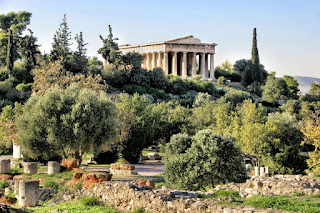The Agora was the centre of ancient Athens. It was the centre of political,
administrative, commercial and social activities. It was also the religious, cultural and
judicial centre.
The Agora was incessantly inhabited in all periods of the
city’s history. It was a residential and
burial area as early as the Late Neolithic Period (3000 BC). In the early 6th century BC,
during the time of Solon, the Agora became a public area.
After a series of repairs and remodellings it reached its
final rectangular shape in the 2nd century BC. Extensive building activity occurred after
the serious damage made by the Persians in 480-479 BC, by the Romans in 89 BC,
while after the Slavic invasion in 580 AD it was abandoned.
From the Byzantine period until after 1834, when Athens
became the capital of the independent
Greek state the Agora became again a residential area.
The first excavation campaigns were carried out by the Greek
Archaeological Society in 1859-1912 and by the German Archaeological Society
1896-1897. In 1890-91, a deep trench cut out for the Athens-Piraeus Railway brought
to light extensive remains of ancient buildings. In 193, the American School of Classical
Studies started systematic excavations with the support of J. Rockefeller and
continued until 1941. Work was resumed
in 1945, after the end of World War II and is still continuing In order tom to excavate the whole area it
was necessary to demolish around 400 modern buildings covering the whole area of 12 hectares.
During the 19th Century the four colossal figures
of Giants and Tritons at the facade of the Gymnasium were restored by the Greek
Archaeological Society. In the years
1953-1956 the Stoa of Attalos was reconstructed and became a museum and in the same period the Byzantine church of
Aghioi Apostoloi, which was built around 1000 AD was restored by the American
School of Athens.
Between 1972-1973 restoration and preservation work was
carried out at the Hephaesteion, the area was cleaned up of the vegetation and
he roof was repaired, in 1978 by the Greek Archaeological Service







No comments:
Post a Comment